North Vietnam, 4th Congress of World Trade Union, August 1st, 1957 (September 25th, 1957 for 300D value), Michel Nr.D17-20 and 63; On occasion of the 4th World Trade Union Congress postal authorities issued five values. Four of them (20D, 40D, 80D and 100D) were intended only for official mail (Su Vu) while the 300D value was for standard mail. Michel reports that the official stamps were issued on August 12th but that does not appear to be correct as both Scott and the Vietnamese Postage Stamp Catalogue report the issuance date as August 1st, 1957. Sheet size was 100 stamps. Perforation of the stamps is 12.5 and, as is often the case, they are very short making it difficult to find well perforated specimen.
Here is the mint set intended for official mail with uniform corner selvage. Note that the 100D stamp shows the plate error “comma shaped object left of D of DONG and open O in Dong”.
Here are blocks of four of the mint set. Note that the top right 20D stamp shows the plate error of “lower part of U in CHU partially missing”. The top left of the 80D stamp shows the plate error “open O in DONG and red horizontal line at bottom left, the top right 80D stamp the plate error “white spots in V of VU and above VU and the bottom left 80D stamp the plate error of “parts of V in VU missing”. The bottom left of the 100D stamp shows the plate error of “white spot on E of LEIPZIG”:
Here are mint blocks of 6 and 3 respectively where the middle left stamps all show the same plate error: broken D in DAN.


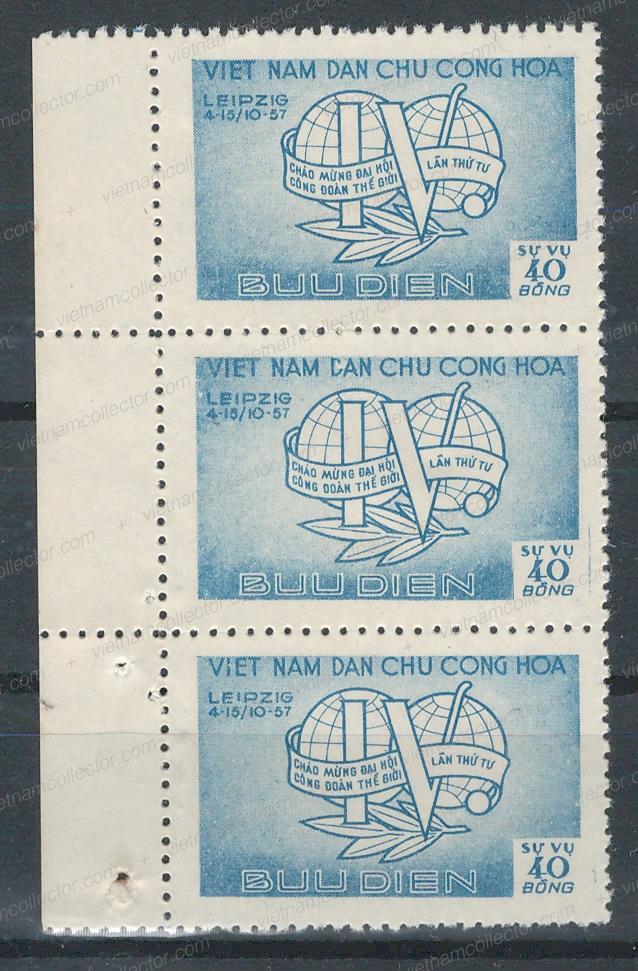

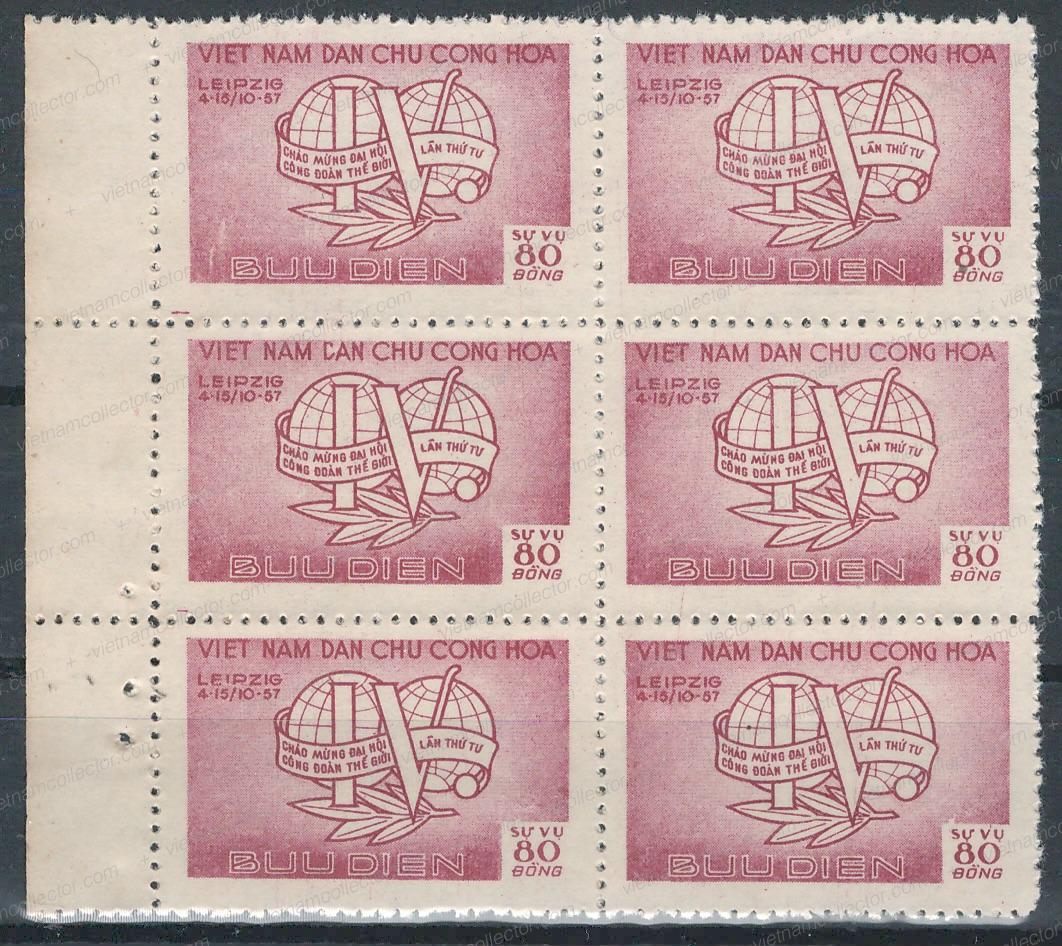

This is the standard stamp of 300D that was intended to cover the standard surface letter rate (up to 20g) to fellow socialist countries that came in force on March 13th, 1957.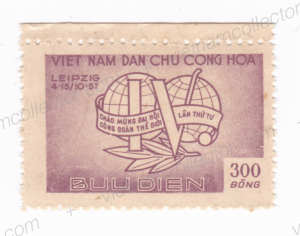
The mint stamp in a block of four:
The plate used for printing all nominals was identical. Only the bottom right corner showing the value was exchanged in the various print runs. In the first print run one value cliche of the 300D value was inserted by error as a mirror image and also upside down. This error was recognized very quickly and immediately corrected. This plate error only occurred once in the sheet of 100 stamps and only in a small print run. This means that it is quite rare. When Michel inserted this plate error in its catalogue it indicated that only twelve of the error stamp existed. That may have been true at that time but subsequently a number of additional sheets with the error were discovered in the postal archives which were then released into the philatelic market making the error stamp a bit more available. Still a very rare stamp. Michel values it at €350 mint and -.- (cannot be valued due to a lack of market activity) for used.
Here is a single specimen along with a detailed scan of the error.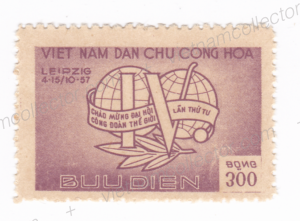
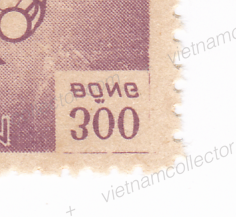
Here is a mint block of four with the error stamp being in the bottom left.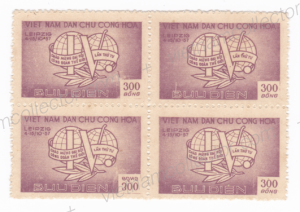
Used samples of the error are quite a bit scarcer than mint copies. Here is a used block of four with the error stamp being at the top left.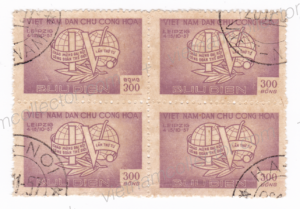
Perforation errors are pretty rare. Here is a pair of 40 Dong Official Stamp where the sheet got stuck so that the perforation comb struck twice in the middle but left the left side of the left stamp as imperforated.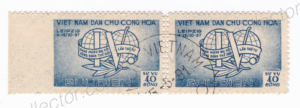
This is a very rarer single specimen of the 80D Official Stamp that shows the print image on both sides! This is not a so called “kiss” that would be a mirror image but an actual right side print. Both sides of the stamp are shown here.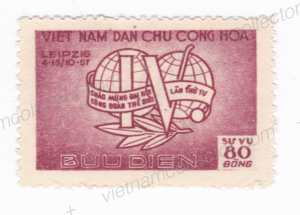
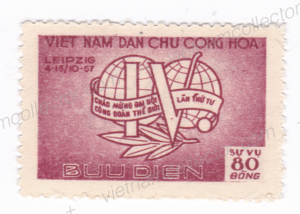 The large majority of used stamps is cancelled to order as this complete set clearly shows. Note that the 80D stamp shows the plate error “white spot under 15 of 4-15”.
The large majority of used stamps is cancelled to order as this complete set clearly shows. Note that the 80D stamp shows the plate error “white spot under 15 of 4-15”.
Here are blocks of four of the 20D and 40D values showing the CTO cancel Hanoi as it was typically struck over four stamps.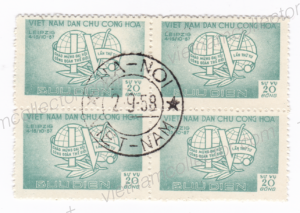
Postally used specimen are much harder to find as it was prohibited to take official envelopes home. So, most surviving postally used stamps come from mail that was sent to international destinations where it could be collected. In over 25 years of collecting Vietnam stamps the editor has yet to complete a postally used set. Here are the values that could be collected so far. Postally used stamps are worth at least ten times the value of CTO stamps.
This is a very rare block of four of the 80D value used in Yen-Bai on October 9th, 1957.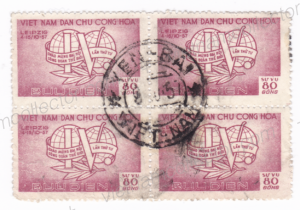
Complete letters bearing these stamps are pretty rare, which is especially true for all the service stamps. Here is a letter franked with a single 300D stamp and two other early NVN stamps for a total postage of 650D from March, 1958. The standard surface letter rate was 300D and the airmail surcharge for most Eastern European countries amounted to 350D (per 5 g). Please note that the discoloration surrounding the 300D value is not a defect as the stamps were issued without gum and gum arabica (whose residue is seen here) was used to affix them. 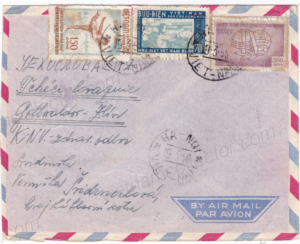
Another mixed franking from January of 1958 sent from Hanoi to Czechoslovakia using the 300D World Union Congress stamp plus one 150D Liberation of Hanoi and 200D Bai Thu’o’ng stamp (Perf. 11.5) for an overall postage of 650D.
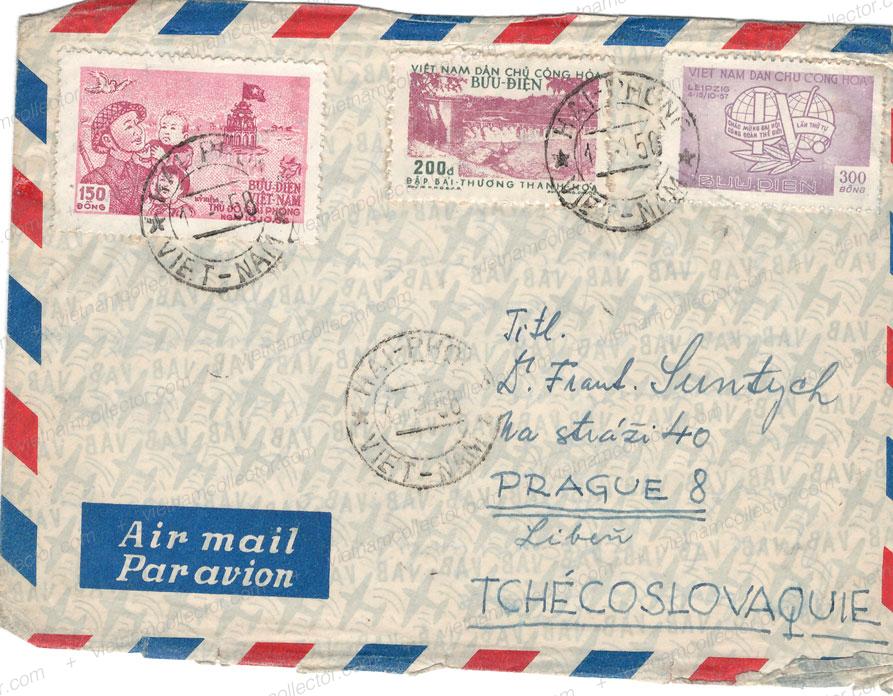
Very rare single franking of the 300D stamp on a November 26th, 1957 letter to Brno, Slovakia. The surface letter rate had just increased from 200D to 300D on March 13th, 1957 so the overall postage was correct.
This is a large air mail envelope with an interesting mixed currency franking from 1962. Let us remember that the Old Dong was devalued on March 1, 1959 by 1000:1, which means that the two values in that currency (one of them the 300D World Trade Union value) were worth 1.3 Dong or 130 Xu. A single stamp of the Mechanisation of Agriculture from 1962 (Michel Nr. 216) completed the franking to total 136 Xu. Canada was a rather unusual and rare destination in 1962.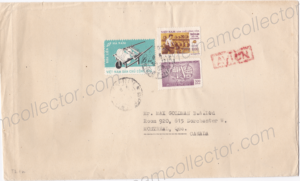
Air Mail Letter from an employee of the East German Embassy mailed October 29th, 1957 to East Berlin. Embassies were able to obtain official stamps for their use. The letter carries all four values of the official World Trade Union set and other early NVN stamps for a total postage of 990 Dong indicting an air mail letter weighing between 5 to 10g (slightly under-franked by 10D).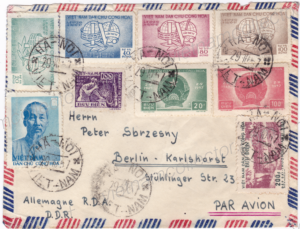
Mixed currency franking between service stamps and general public stamps on a letter from Hanoi to East Germany. The sender was most likely a member of the East German Embassy and hence had access to service stamps. The 40D Land Reform service stamp had been devalued by 1,000:1 on March 1st, 1959 soit was only worth 4xu at the time of mailing. Together with the other NVN stamps in new currency the franking amounted to 13xu which was 1xu above the required 12xu tariff. Note that the traces of gum arabicum on the envelope do not represent damage. The stamps were issued without gum so had to be affixed with gum arabicum that led to the stains.
Mixed currency franking between a service stamp and general public stamps on a letter from Hanoi to Sonneberg, East Germany. It is unclear why the sender was able to use a service stamp on his correspondence. . The 40D Land Reform service stamp had been devalued by 1,000:1 on March 1st, 1959 so it was only worth 4xu at the time of mailing. Together with the other NVN stamps in new currency the franking amounted to 12xu which was the correct tariff to East Germany at the time.
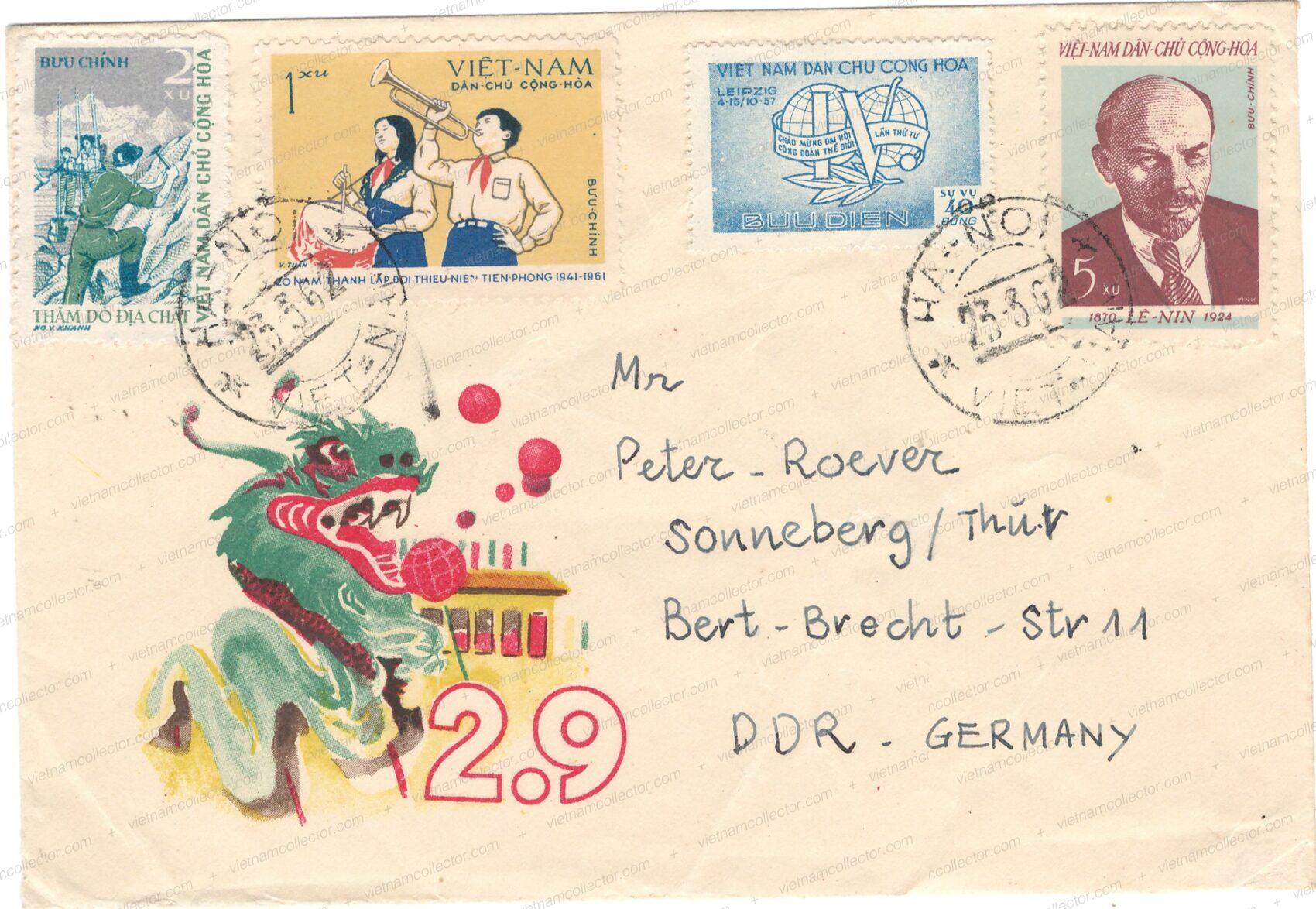
Mixed franking between normal stamps and the complete set of the official Union Congress set on an envelope sent by a member of the East German Consulate to East Germany in February of 1958. The overall postage amounted to 1,100D.
Very rare official letter sent in May of 1959 to an engineer school in East Germany featuring strips of three of the 40d Union Congress and 80D Hanoi Stadium official stamps for an overall postage of 360D.
Mixed franking most likely from a member of the East German Consulate (which had access to official stamps) featuring a mix of regular stamps and two official Union Congress stamps (40D and 100D) for an overall postage of 1,740D. The letter was registered. The basic surface letter rate abroad amounted to 300D, the air mail surcharge to 350D (for every 5g) and the registration fee to 600D. So this letter must have weighed between 10-15g.
Rare Specimen/Printed Matter Xunhasaba mailing from February of 1965. The letter carries a mix of regular stamps (Phu Lo’i and Folk Dance sets) plus one of the 40 xu Official Union Congress stamps for an overall postage of 1.10D. West Germany was still a rare destination in the early 1960’s.
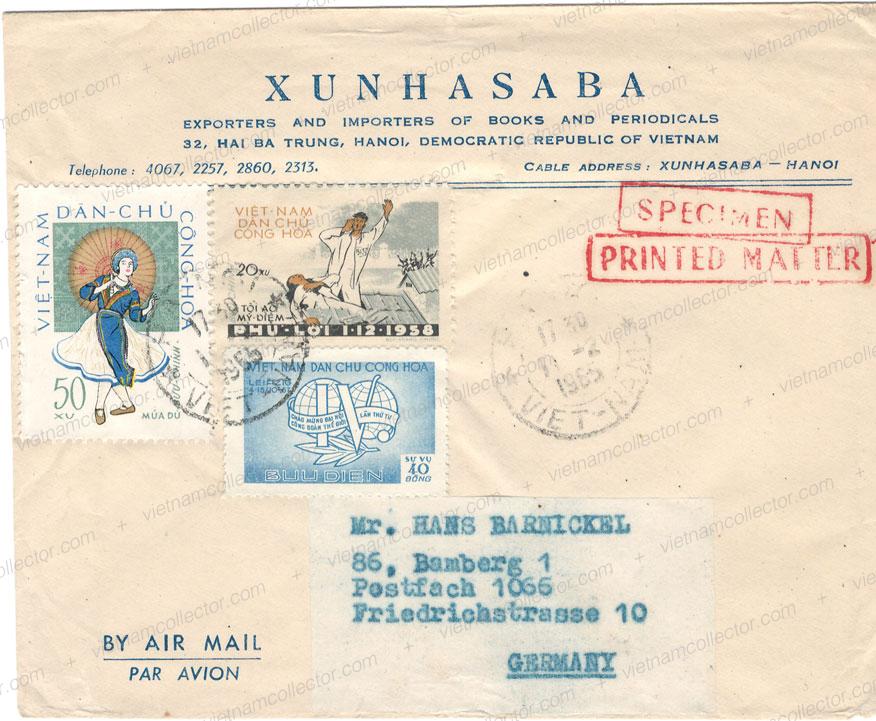
Rare Specimen/Printed Matter Xunhasaba mailing from March of 1964. The letter carries a mix of regular stamps plus one of the 80D Official Union Congress stamps for an overall postage of 740D. England was still a rare destination in the early 1960’s.
Mixed franking of general and official stamps sent by a member of the East German Embassy to Saxony, East Germany in 1962. Embassy workers had access to official service stamps. The letter also represents a mixed currency franking of 40 Old Dong (devalued to 4 xu in the March 1st, 1959 devaluation) and 8 new Xu for an overall postage of 12 xu. As of March 1st, 1960 the standard letter rate to Socialist countries was identical to the inland standard letter rate (12 xu). Note that the 40D stamp shows the plate error “white spot in left vertical line of H in HOA”.
Local letters with official stamps are exceedingly rare as it was prohibited to take them home from the office. Most of them were collected by the well known philatelist Klewitz who had a high level contact in the Vietnamese Government who apparently felt secure enough in sending him official envelopes. Since he did not speak Vietnamese he collaborated with the East German Gregor Schwirtz who was a linguist and who did speak Vietnamese. Here is a letter (ex Klewitz/Schwirtz) to which Schwirtz writes: “Official Letter to the Government, December 23rd, 1957, Added 10D standard stamp. Red Cachet: Sender, District Chief of the Western Province Vinh in Nghe An.” The letter carries the 40D and 100D value of the World Trade Union set. The total postage of 150D represents the standard domestic letter rate in force since November 1st, 1957. Hanoi arrival cancel on the reverse.
Another very rare local letter ex Klewitz/Schwirtz. Schwirtz comments: “Official letter to the Government; December 28th, 1957, Addition: 50 Dong standard stamp, witness: the 20D Official stamp in deep dark color. Official mail; due to an increase of postage for local letters at the end of 1957 (also official mail) to 150 Dong caused shortage of suitable values which led to mixed frankings; lacking official stamps were replaced by standard stamps.” Based on the short address this stamps was mailed inside Hanoi.
Very rare letter from the Bank of Vietnam in Lang Son Province to the bank of the Peoples Republic of China on Nan Ninh City (Guanxi Province). Red Lang Son transit cancel and Nan Ninh arrival cancel on the reverse. Carrying the 80D and 10D value of the World Trade Union set along with a pair of the 150D official stamps of “Defense of the Country” from 1958 (Michel Nr. D27).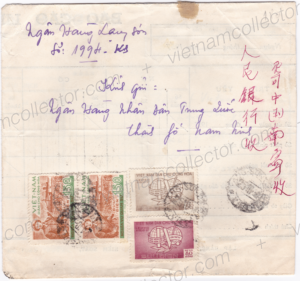
Official letter sent in June of 1959 by the Vietnamese Red Cross to the Red Cross headquarters in Geneva, Switzerland. The letter features a mixed franking of the 100D World Congress service stamp and the 500D Production and Thrift general postage stamp for an overall franking of 600D.
Large envelope sent in June of 1960 by a member of the Czechoslovakian Embassy and by registered mail to Czechoslovakia. This letter is interesting in that it features a triple mix franking of official service stamps and general postage stamps in Old and New Dong. The collection of Old Dong stamps (August Revolution, Cam Phase Mine, Trade Exhibition, Peoples Sport, Union Congress and Democratic Women) amounted to a total of 3,650, the official World Union Congress stamps to 200D and as of March 1st, 1959 were worth only 3.85 New Dong. Together with the stamps in New Dong (Hong-Xuan Sluice, Radio Station Me Tri, 10 Years Peoples Republic of China, Women Day, Hung Vu’o’ng Temple and National Assembly) that amounted to 0.63xu the total postage came to 4.48 New Dong. Very unusual and rare combination.
Registration Nr.100060

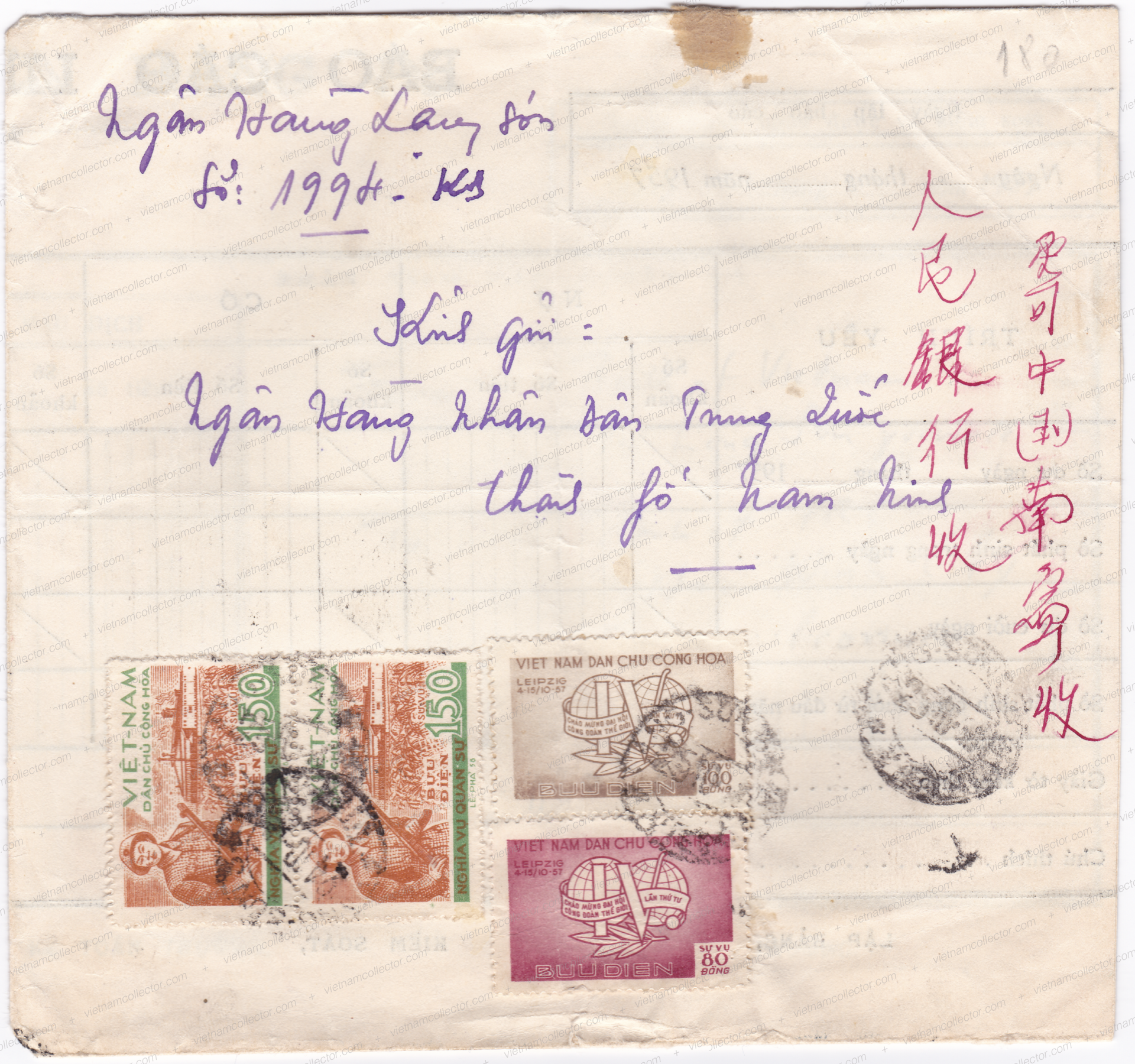

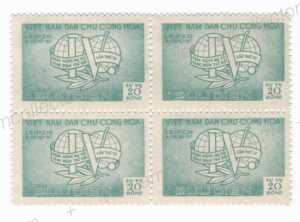
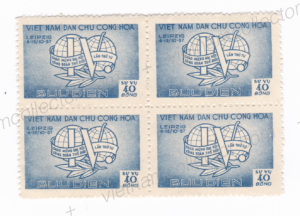
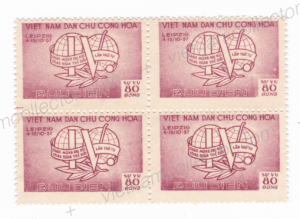
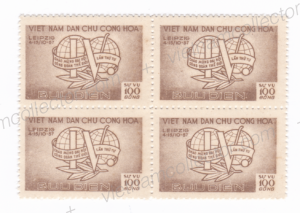
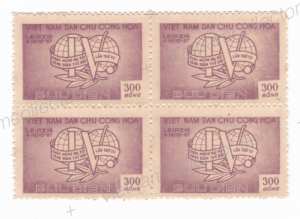
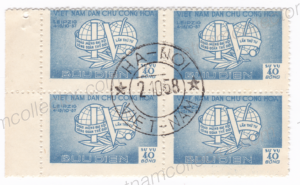
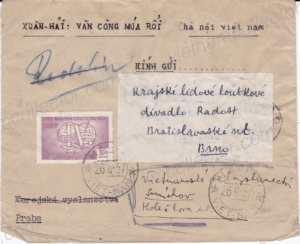
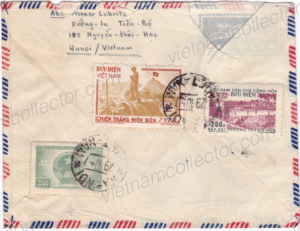
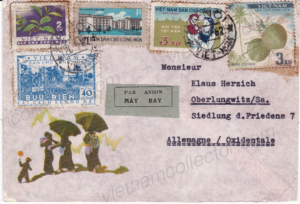
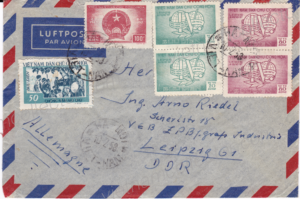
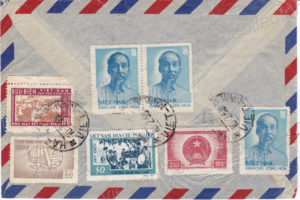
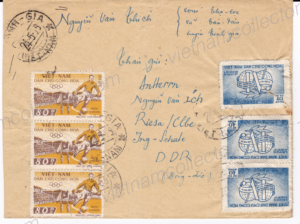
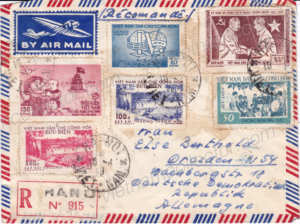
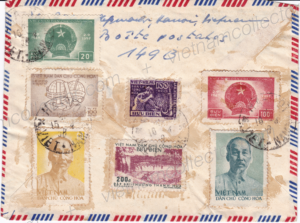
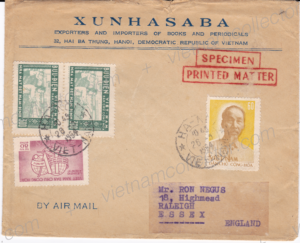
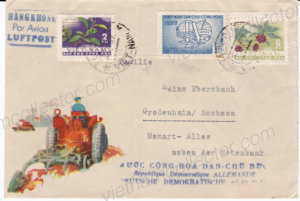
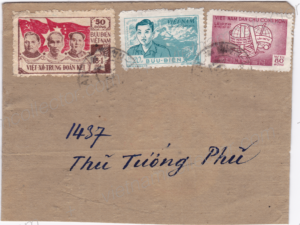
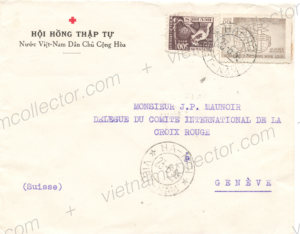
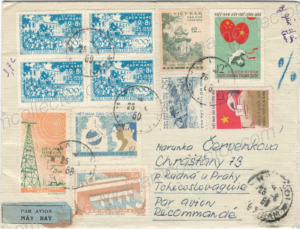
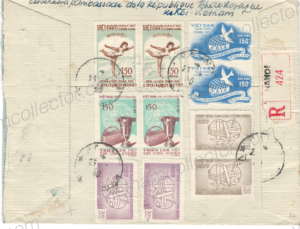
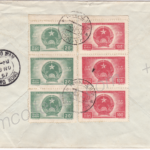
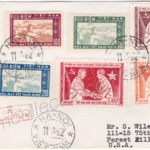


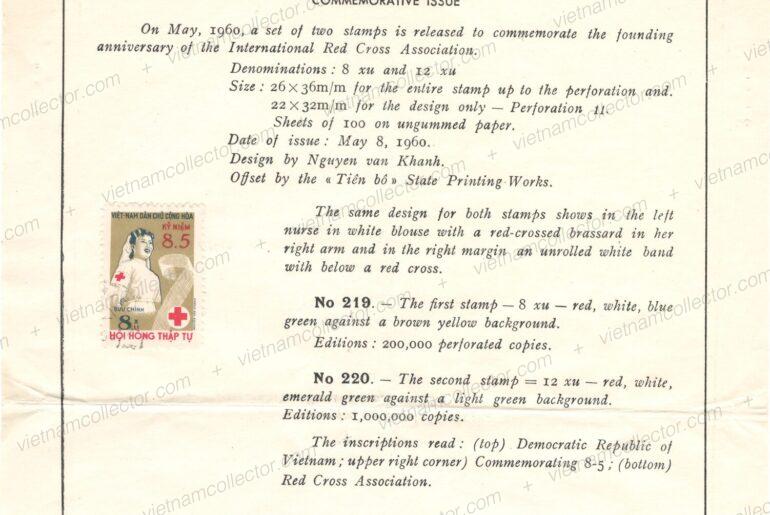
Comments are closed.